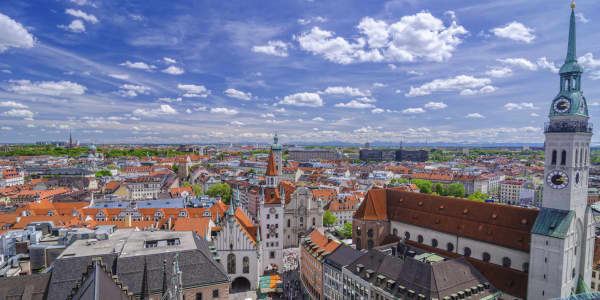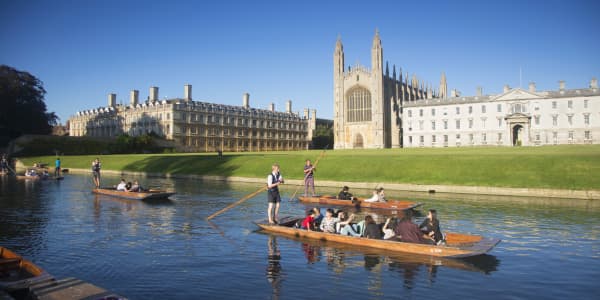The world's most spectacular stadiums
Nothing beats the thrill of watching live sport. The stadiums we visit to get our sporting fix are fast becoming architectural trailblazers; buildings that inspire wonder with their scale, and admiration with their green credentials and cutting edge technology.
Here, we take a look at 10 of the world's most striking, spectacular and innovative stadiums – some of them used in major sporting events such as the Olympics and World Cup – and assess their impact, influence and technological merit.
By Anmar Frangoul and Hamza Ali, special to CNBC.com
Arena das Dunas
Location: Natal, Brazil
Capacity: 42,000
Located in Natal, on Brazil's north-east coast, the Arena das Dunas hosted four group matches during this summer's World Cup.
Delivered on time and under budget, its design is inspired by the region's undulating sand dunes – dunas in Portuguese. The stadium's design also ensures an abundance of ventilation and natural light.
The stadium has been hailed as one of the "greenest" arenas of the World Cup, with a roof designed to store and re-use rainwater.
According to Populous, the architects that designed the stadium, "up to 3,000 cubic meters [of rainwater] may be captured and reused in the lavatories and for irrigating the pitch."
SGL Arena
Location: Augsburg, Germany
Capacity: 30,660
FC Augsburg may be a mid-table team in the German Bundesliga – the country's top soccer league – but the club's stadium is streets ahead of the competition when it comes to green credentials.
Opened in 2009, the stadium uses groundwater drawn from six 40-meter wells to generate heat, saving more than 700 tons of CO2 per year.
Photovoltaic solar panels on the roof generate electricity, and there is a charging station for electric bikes and scooters outside the ground.
Estádio Municipal de Braga
Location: Braga, Portugal
Capacity: 30,286
Designed by the award-winning Portuguese architect Eduardo Souto de Moura and built for the Euro 2004 soccer championships, the Estádio Municipal de Braga is among the most impressive on the planet.
Built on the site of a former quarry, the stadium has only two stands along the side of its pitch, with the goal ends buttressed by the imposing rock of the former quarry at one end, and a sweeping view of the city at the other.
Olympic Stadium
Location: London, United Kingdom
Capacity: 54,000
It may have been the venue for some record-breaking races, but the stadium that hosted the London Olympics is also a model of sustainability.
Located within the Queen Elizabeth Olympic Park – the largest such facility to be built in Europe for 150 years – and built on an island surrounded by canals and waterways, just 10,000 tons of steel were used to build it, making it the lightest Olympic stadium ever.
Some 52 tons of scrap metal, including knives and guns collected in a Metropolitan Police amnesty, were used in the stadium's construction, while its iconic "roof ring" used surplus pipes originally made for the North Sea gas fields.
The stadium is set to re-open in 2016, when it will be used as the home ground of West Ham United Football Club.
Sun Life Stadium
Location: Miami, Florida, United States
Capacity: 75,540
Home to the Miami Dolphins, the Sun Life Stadium is very technologically advanced, making it one of the most welcoming for its visitors.
An IBM Intelligent Operations Center enables stadium management to make use of real-time information – a combination of turnstile data and live video feeds – to ensure that fans entering the arena are directed by digital signs to the shortest queues possible.
Fans' spending habits can also be monitored, so that hot dogs, beers and nachos can be replenished when running low.
Lincoln Financial Field
Location: Philadelphia, Pennsylvania, United States
Capacity: 67,594
The Lincoln Financial Field, where NFL franchise Philadelphia Eagles play their games, also wears its green credentials proudly.
Over 11,000 solar panels and 14 micro-wind turbines have been installed on the stadium and surrounding complex. The solar panels can generate almost 30-35 percent of the stadium's yearly electricity consumption.
In 2013, Lincoln Financial Field earned further plaudits when People for the Ethical Treatment of Animals (PETA) named it the most vegetarian-friendly stadium in the NFL.
AT&T Stadium
Location: Arlington, Texas, United States
Capacity: 80,000
Like the state of Texas, the home of the Dallas Cowboys is big.
At 61,390 square meters, its roof is described by the Cowboys as "one of the largest domed sports structures in the world" and can be opened or closed in just 12 minutes, giving spectators ventilation and natural light, as well as cutting down energy use in the process.
The stadium also has the world's largest glass doors, standing 180-feet wide and 120-feet high, an innovative bio-composting reactor, and permeable pavements that improve drainage.
Sapporo Dome
Location: Sapporo, Japan
Capacity: 67,400
The host of three group games in the 2002 World Cup, the Sapporo Dome is home to both soccer and baseball teams. The stadium boasts a system which 'slides' a grass soccer pitch in and out of the arena, as and when required.
The Sapporo Dome's silver roof has been designed so that the heavy winter snows that are common in Sapporo slide off, thereby removing the threat of a dangerous strain on the structure.
Arena Castelão
Location: Fortaleza, Brazil
Capacity: 67,037
In preparation for the 2014 World Cup, part of this stadium – first opened in 1973 – was demolished.
During its reconstruction, 97 percent of the waste material was re-used or recycled, while energy consumption is reduced by 12.7 percent per year thanks to "smart building optimization", according to the U.S. Green Building Council.
The stadium's roof collects rainwater which that is used in bathrooms and for irrigation, cutting the amount of potable water consumption by 67 percent.
With all of these green savings, the Arena Castelão became the first of Brazil's World Cup stadiums to attain Leadership in Energy and Environmental Design (LEED) certification.
Estádio Maracanã
Location: Rio de Janeiro, Brazil
Capacity: 78,838
One of the world's most iconic stadiums, the Maracanã, hosted this year's World Cup final between Germany and Argentina. It was the first time a final of the tournament has been played in a solar-powered stadium.
More than 1,500 solar panels are installed on the stadium's roof, generating enough energy to power 240 homes per year and saving more than 2,500 tonnes of CO2 per year.
Rainwater is also captured and used in the stadium's bathrooms and to irrigate the pitch, helping to reduce water consumption by up to 30 percent.
The Maracanã is used by Rio's biggest soccer clubs – Flamengo, Botafogo and Fluminense – and will also host the 2016 Rio Olympics, ensuring a long-lasting legacy beyond 2014.




